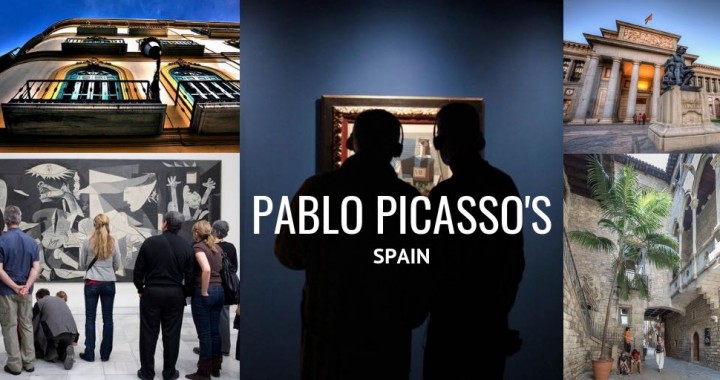Although Pablo Picasso lived in France for much of his adult life, it’s impossible to understate the influence of his Spanish upbringing on his art. To gain some insight into the exiled champion of cubism, neo-classicism, and surrealism, here at Totally Spain we highly recommend a trip to Malaga, Barcelona & Madrid. That’s where you can visit the places that meant so much to him and see some of his iconic works such as ‘Guernica’ in person.
Pablo Picasso’s Spain
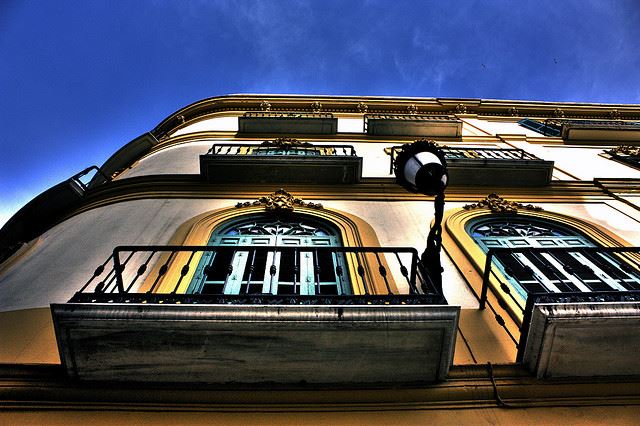
Picasso’s balcony. You can spend an entire week visiting museums in Malaga but the Picasso fans will head for the two Picasso spaces first. photo credit: Two Steps Behind via photopin cc
1 Picasso in Malaga 1881-1890 (with visits thereafter)
The journey starts in Malaga where Pablo Picasso was born on 25 October in 1881. Malaga is a wonderful city (with a large international airport to fly into) but for Picasso fans, it is where the maestro first picked up his pencil and paints (they were in abundant supply at home because his father was an artist and professor of painting) and where he continued to learn about light and form on his return visits to the city when on holidays.
First up to visit is the Picasso Museum located inside Buenavista Palace, a 16th century Renaissance building with Mudejar elements also that has housed more than 200 items of Picasso’s works since 2003 when they came from the private collections of two relatives, Christine Ruiz-Picasso (daughter-in-law) and Bernard Ruiz-Picasso (grandson). We can book you on a private guided tour to get the most from your visit to this museum which has been in the making ever since the artist first expressed his wish to exhibit his work in Malaga back in 1953.
The second museum to visit is the painter’s childhood home in Malaga too. This museum is on the first-floor of the building in Plaza de la Merced where he was born and the three rooms are well-preserved and offer insight into the work of the painter. As you walk around the rooms, you have to imagine the teenager with his big dreams!
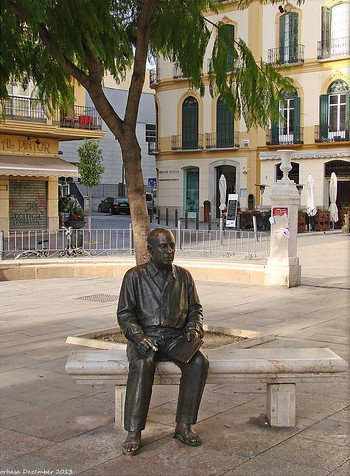
The man himself outside the place of his birth in Malaga. photo credit: Jorbasa Malaga/Andalusien -Skulptur Pablo Picassos via photopin (license)
If you still have time left in the city, make your way to the City Museum where you’ll find Picasso’s Carpeta La Tauromaquia (Bullfight Folder) with 26 depictions of the fight – along with a number of other works by Picasso donated by the painter’s personal secretary, Jaime Sabartes. Picasso went to bullfights with his father in Malaga and you can find the Malagueta bullring that dates from 1876 which obviously left its mark on the painter.
Before you leave Malaga, if you enjoy visiting churches, pop into the parish church of Santiago on Calle Granada, where Picasso’s parents were wed and where he and his siblings were baptised.
Insider Tip: Rather than standing in a line with the hundreds of others eager to see Picasso’s work in Malaga and elsewhere, make sure you pre-book tickets for all the Picasso museums! Or get onto a professional such as ourselves to do this all for you in conjunction with a complete Custom Spain Tour. In addition to pre-booking your ticket to the museums, we can also arrange a private guided tour of the cities where you’ll see and hear a lot of anecdotes about the painter and the place.
2 Picasso in Galicia 1890-1895
Although rarely referenced as a key Picasso destination, when Picasso was 10, his father secured a teaching position in A Coruna in Galicia bringing Picasso’s family to the Northern city for five years (although he returned to Malaga during the Summer holidays). You’ll find a Picasso House Museum here and we can arrange a walking tour of the locations of importance to him that include Orzan beach, Hercules Tower and the Rosalia Theatre. Ultimately, the city bore sad memories for the artist and his family following the death of Conchita, Picasso’s sister from diphtheria in 1895. If you visit the house museum, you’ll see some re-productions by Picasso and his father. For other things to do in Coruna, check out our guide to the city here.
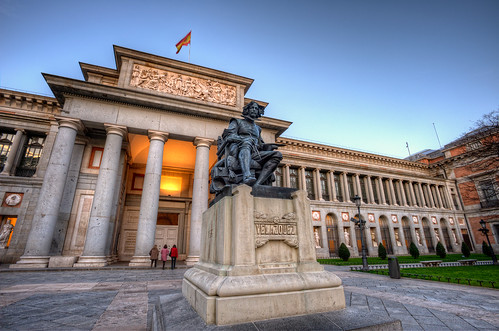
Madrid’s Prado Gallery- where Picasso spent much of his time in the city. photo credit: marcp_dmoz Museum – Museo del Prado, Madrid (Spain), HDR via photopin (license)
3 Picasso in Madrid 1895/1897+
Picasso’s family moved briefly to Madrid in 1895 but later that same year they moved again to Barcelona where Picasso spent two years at the Llotja School of Fine Art – and then relocated with the family back to Madrid – with Picasso taking a place to study at San Fernando Royal Academy of Fine Art. The institute is still open today and you can visit the museum to see the great artists who have passed through these doors.
While in Madrid, you should visit the Prado Museum – where Picasso was to be found visiting during his time in Madrid. He loved the work of El Greco and Velazquez – and we can organise a private guided tour of the works of these artists that inspired him deeply.
Next stop – although it upsets the chronology – is the Reina Sofia Museum where you’ll find Picasso’s ‘Guernica’ on show. In January 1937 Picasso was commissioned by the Republican government of Spain to paint a mural for the Spanish pavilion at the Paris Expo of 1937. He was at this stage the appointed director of the Prado Museum in Madrid – although it’s not clear that he ever travelled to Madrid from France to take up the role as the Civil War had broken out. In ‘Guernica’, Picasso chooses to focus on the Nazi aerial bombing of Guernica in the mural – depicting the horror of war and the suffering it inflicts upon individuals. It was first exhibited in Paris and was then sent to the US until 1981 when it was returned to Spain to the Prado. It was transferred to the Reina Sofia when the museum opened to the public in 1992. In addition to seeing the piece itself at the Reina Sofia, Picasso fans can learn much about the mural thanks to Dora Maar’s photography of the work in progress, which you can here.
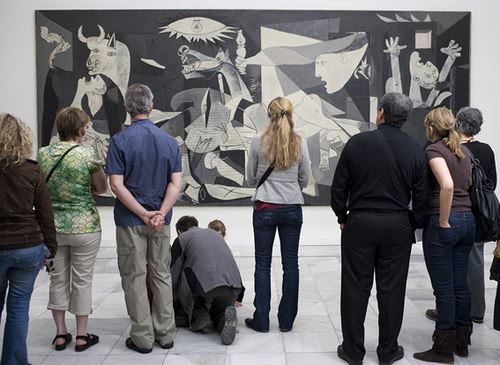
Experiencing the most famous work of Spanish art – Guernica – at the Reina Sofia museum in Madrid – which is free all day Sunday. photo credit: Museo Reina Sofía via photopin cc
After visiting ‘Guernica’ – we highly recommend changing the atmosphere by visiting the museum’s NuBel café on Calle Argumosa, 43 (inside the Nouvel building), featured in our post on the Best Museum Cafes/Restaurants in Spain. For its sheer colour, coolness and sense of fun and creativity, thanks to a recent re-design by Paula Morales, this funky design and colour scheme will shake you out of the horror you’ve been through by looking at ‘Guernica’.
When you are ready to see more of Picasso’s art, you’ll find eight wonderful pieces dating from 1904 to 1934 in Madrid’s Thyssen-Bornemisza Museum with some handy gifts in the museum store also. And you might want to see the 71 works on display as part of Picasso’s barber’s art collection. Yes – surreal, isn’t it? It’s called the Picasso Museum – Eugenio Arias Collection in Buitrago del Lozoya which is a 50-min drive (without traffic) from downtown Madrid. The museum is located in Plaza de Picasso, 1 – and, yes, we can arrange a transfer from your hotel there and back, once again, as part of a complete Custom Spain tour.
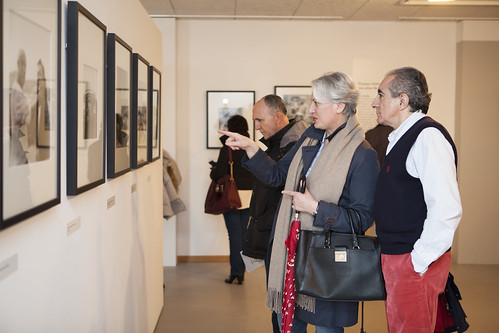
Picasso’s barber’s art collection forms the backbone of this Picasso Museum outside Madrid. photo credit: museopicasso Inauguración de la exposición ‘Picasso visto por Edward Quinn’ via photopin (license)
4 Picasso in Barcelona 1895/1998+
When Picasso finished his studies in Madrid, he moved to Barcelona and set up a studio on Carrer de Escudillers Blancs, 2 in 1898. Two years late he moved to a different studio on Calle Riera de San Juan, 17 – which is when he had his first exhibition in Els Quatre Gats, the ‘salon’ for the avant-garde artists of that time. You can visit the café/restaurant and raise a toast to Picasso who even designed the menu there.
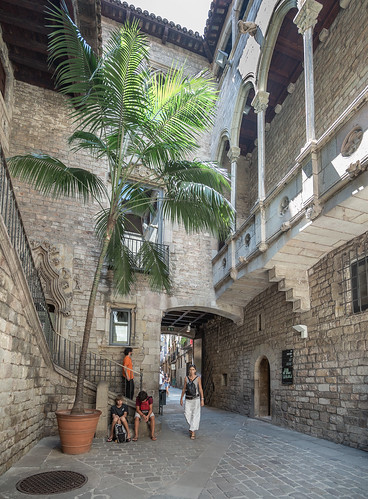
If you like the outside, you’ll adore the contents of the Picasso Museum in Barcelona! photo credit: Edgardo W. Olivera Museo Picasso, Barcelona, España via photopin (license)
In 1902, Picasso moves studio to Calle Nueva 6 (called Conde de Asalto) – while also spending significant amount of time in Paris. In 1903, his studio moves to Calle Riera de San Juan, 17 – and he moves again to Calle de Comercio, 28 – but ultimately moves to Paris – but still returning to Barcelona on visits – up until 1934 – which is the last time he steps on Spanish soil. Spain’s loss is definitely France’s gain.
Having visited some of the studio locations and Els Quatre Gats, you’ll want to go to the Picasso Museum in Barcelona (which opened in 1963) where you’ll find engravings, ceramics and paintings by Picasso in chronological order. It’s one of the most significant spaces dedicated to the painter – with over 4,000 works in the collection – and most visitors cite his ‘Las Meninas’ series here as the highlight of the visit.
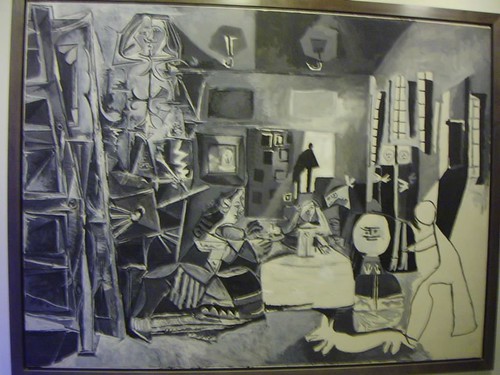
The acclaimed Las Meninas series on show in the Picasso Museum of Barcelona. photo credit: d.vanthorre 24-03-02 – 03 Picasso via photopin (license)
If you have some time to spare near Barcelona, the city of Sitges is home to the Cau Ferret museum featuring the work of a contemporary of Picasso, Santiago Rusiñol and you’ll find work by Picasso here also. Picasso painted a great number of portraits of Rusiñol and you can read about the curious relationship between the two painters here.
If you have more time in this area, you might want to call into Horta de Sant Joan where you’ll find 200 reproductions of works that were created by Picasso while he stayed here. He first visited as a 16-year-old and came back a decade later – and the progression in the work over those 10 years is just one of the many features that stand out. You’ll also see how his signature changed.
5 Picasso In Exile 1934-1973
From Barcelona, as we said earlier, Picasso moves to France where he lived for the rest of his life. He died in 1973 – aged 91 – leaving behind an estimated body of work of 13,500 paintings, 10,000 prints and engravings, and 34,000 illustrations. Unfortunately, he didn’t live to see his most famous work ‘Guernica’ on show in Spain nor did he live to see Spain emerge from the dictatorship which had seen him in exile for almost four decades.
6 Additional Picasso Points of Interest in Spain:-
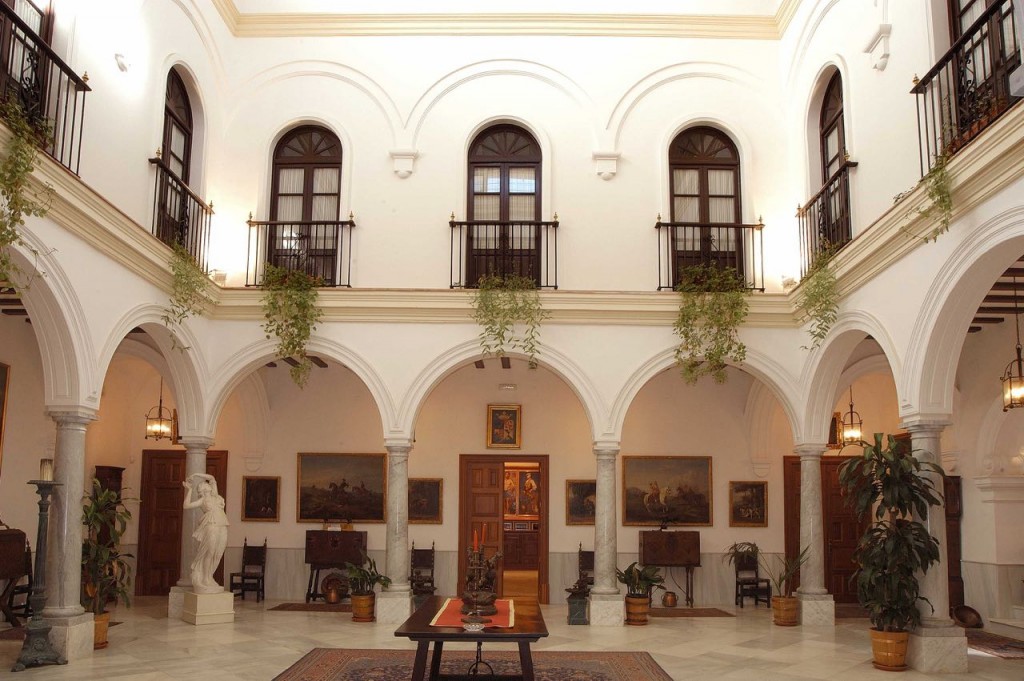
Picasso’s Suite Villard and other works by Dalí, Botero, Miró, Tàpies and Chillida can be enjoyed at Grupo Estevex sherry winery in Jerez. Pic credit: Grupo Estevez
If you’ve read our post on Wineries with Art in Spain, you’ll already know that Picasso’s Vollard Suite at Grupo Estevez in Jerez is home to one of the most important print collections by Picasso – often referred to as the precursor to Guernica. Inside the winery, you’ll see 97 prints from the collection plus three portraits of Ambroise Vollard who was Picasso’s art dealer and commissioned these works that were created from 1930 to 1936. The four themes to the works are Minotaurs (man-beast), the Battle of Love, Rembrandt and the Sculptor’s studio. This collection was purchased in 2002 to bring art to the forefront of this sherry winery where you’ll also find works on show by Dalí, Botero, Miró, Tàpies and Chillida.
And the same post about Wineries with amazing art also features the Picasso on show at the Vivanco Museum in La Rioja. You’ll also have the pleasure of learning and seeing how wine has inspired artists such as Sorolla, Joan Miró and Juan Gris to name but a few. The Vivanco wines are intrinsically linked to the artworks as you can see in the video about Miró here.
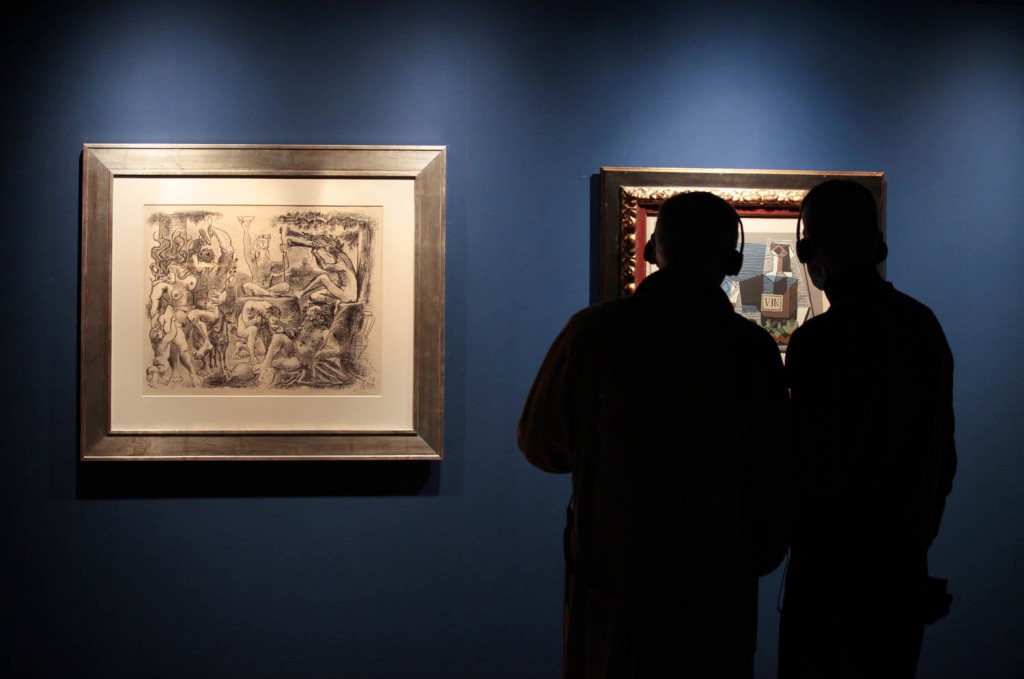
All eyes are on the Picasso at Vivanco’s Museum of Wine Culture – but there’s also the Sorolla, Joan Miró and Juan Gris to enjoy. Pic credit: Vivanco
7 Picasso’s Spain – How to Get Around & Where to Stay
The top three Picasso destinations of Malaga, Madrid and Barcelona are connected by high-speed train (see our post about these amazing trains here). We love the convenience, comfort and speed of the AVE trains and always make sure you are met at the stations by one of our private drivers. We recommend at least two nights in Malaga, Madrid and Barcelona to really enjoy your time with Picasso. Get in touch for details on our favourite hotels in Malaga, Madrid & Barcelona – and remember at Totally Spain we tailor each itinerary just for you and your travelling party!
